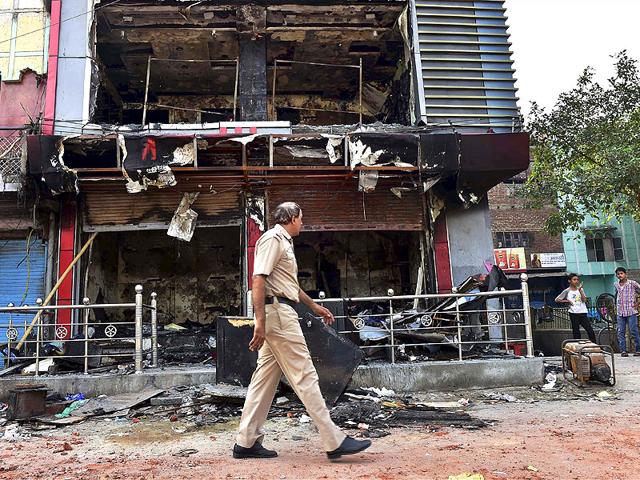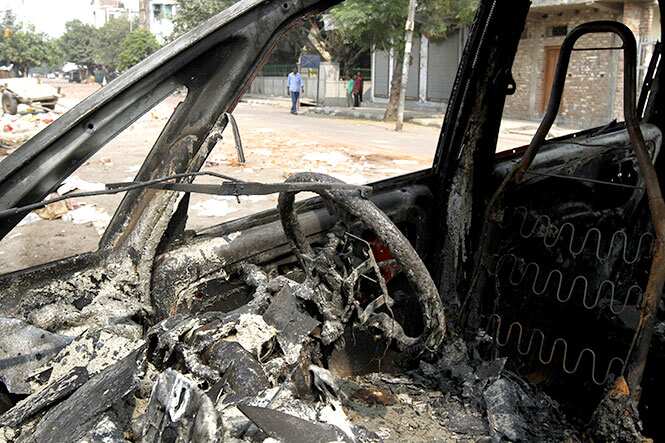No ordinary crime: What's behind Trilokpuri riots
It's time we should stop seeing communal violence as a simple law and order problem. Authorities should instead identify the deeper causes that lead to such clashes, writes KumKum Dasgupta.
The one and the only time I have ever been to Trilokpuri was in 2001. I was on a late night shift and had opted for office transport. After dropping my colleague in Mayur Vihar Phase 3, the driver decided to take a shortcut via Trilokpuri to my place. "Yeh khatarnak jagah hai. Kuch bhi ho sakta hain," I remember Ramesh telling me that night.


A burnt Tato Nano car is seen after the communal riots in Trilokpuri in East Delhi. (HT Photo/Virendra
Singh Gosain)
I was new to Delhi at that time, but I was aware of : Around 350 Sikhs were reportedly killed here in 1984 riots, and it was still considered an unsafe area.
A congested and haphazardly built locality (many of the houses were half-built), Trilokpuri looked like a neighbourhood that was straddling between two worlds: the rural and urban. I think the locality's character is still the same. Trilokpuri may have urban civic amenities like electricity and piped water, but the locality remains at the social and economic fringe of the metropolis.
On Diwali night, once again. While there is no definitive answer to what led to the flare-up between the Hindus and Muslims, several reasons have been doing the rounds in the media since the news broke: Muslims objected to loudspeakers being played at Mata ki Chowki which is next to a mosque; the riots were a "pre-planned" act; the Delhi Police's inaction allowed a minor incident to take such ugly proportions, and there was a political design behind the flare-up. In fact, AAP has demanded that the police should probe the role of former BJP MLA Sunil Kumar Vaidya in the incident, since there are "credible reports" that he had convened a meeting on Diwali night and trouble started only after that. Then there is of course the in instigating and fuelling riots.
All the reasons mentioned above could be credible ones but I think it's time we should stop seeing riots as a simple law and order problem. Instead, authorities should go beyond a specific event and try to identify the deeper causes that lead to such conflagrations. There could be several such causes: discrimination, poverty, high unemployment, poor schools, poor healthcare, housing inadequacy and police brutality and bias. I am quite sure that several of these--if not all--are also present in Trilokpuri and many of youngsters who came out to participate were angry about their present social and economic status and uncertain futures.
After the 2011 race riots in Britain, the London School of Economics and the Guardian did a full scale study--Reading the Riots--of the flare up and their aftermath. Several of the 'conditions' that lead to riots are could be true for India too: Take for example, the relation between certain (especially poor) communities and the police: in the race-riot areas in Britain, researchers found out that there was anger and frustration at the people's everyday treatment of police. In Trilokpuri, many parents claimed that they took part in the violence to save their sons from police brutality.
Second, the evidence gathered by the study suggested that rioters were generally poorer than the country at large. This holds true for most riots in India, including the recent one at Trilokpuri.
Third, rioters in Britain also identified a number of other motivating grievances from increase in tuition fees, to closure of youth services, and scrapping of the education maintenance allowance and many complained about perceived social and economic injustices. While conditions in India and Britain are vastly different, it is well documented that the lack of a credible social sector net in India and opportunities for people who don't have a certain type of background is fuelling anger among the people--and Trilokpuri could have been the latest casualty of that simmering anger.
It is always easy to blame a party or individuals for instigating riots that cause such immense social dislocation and economic losses, but we must go beyond these easy explanations and look for the deeper causes that make places like Trilokpuri a tinderbox.





